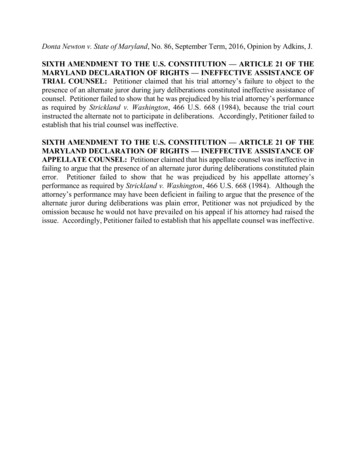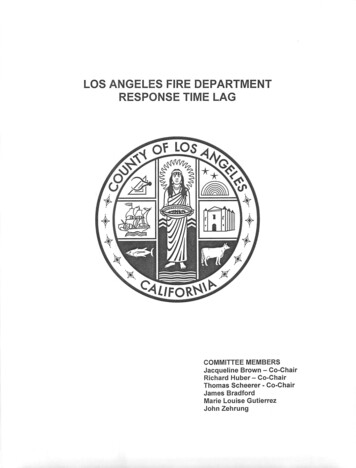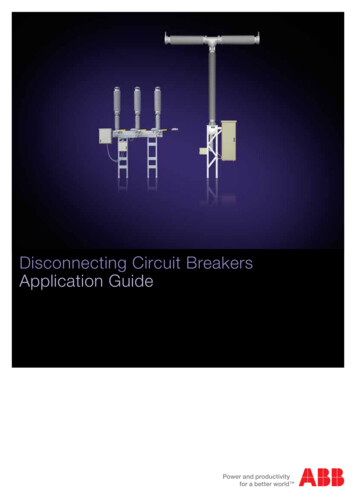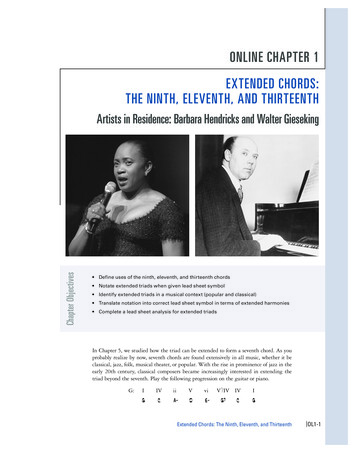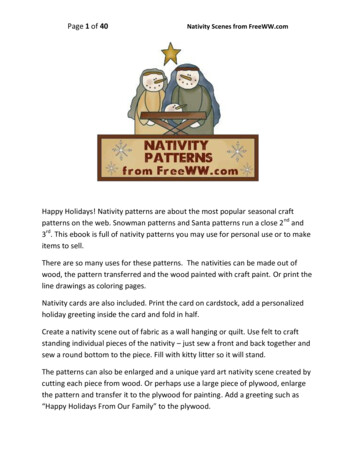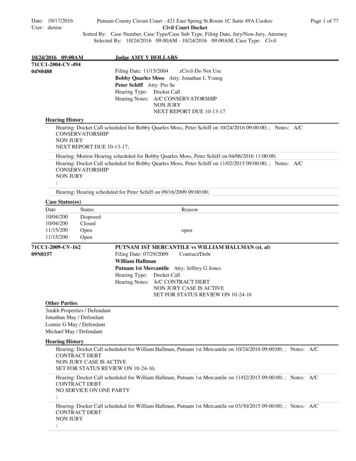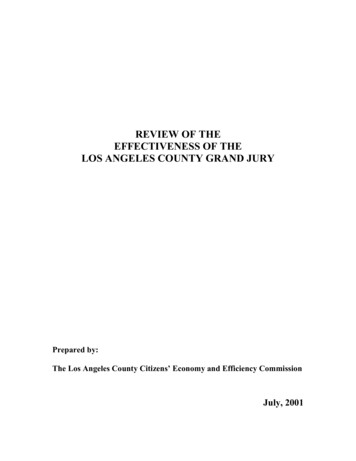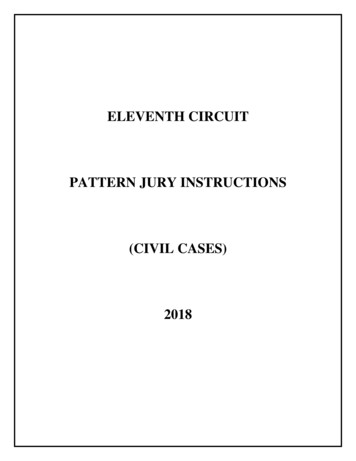
Transcription
ELEVENTH CIRCUITPATTERN JURY INSTRUCTIONS(CIVIL CASES)2018
TABLE OF CONTENTSPRELIMINARY INSTRUCTIONS1.1 General Preliminary Instruction1.2 Burden of Proof - Clear and Convincing Evidence1.3 Official English Translation/Interpretation1.4 Jury Questions1.5 Interim Statements1.6.1 Copyright - Preliminary Instructions1.6.2 Overview of ClaimTRIAL INSTRUCTIONS2.1 Stipulations2.2 Use of Depositions2.3 Use of Recorded Conversations and Transcripts2.4 Interim Statements2.5 Judicial Notice2.6 Use of Interrogatories2.7 In-Trial Instructions on News Coverage2.8 Civil Allen ChargeBASIC INSTRUCTIONS3.1 Introduction3.2 Duty to Follow Instructions - No Corporate Party Involved3.2.2 Duty to Follow Instructions - Corporate Party Involved3.2.3 Duty to Follow Instructions - Government Entity or Agency Involved3.3 Consideration of Direct and Circumstantial Evidence; Argument of Counsel; Comments by theCourt3.4 Credibility of Witnesses3.5.1 Impeachment of Witnesses because of Inconsistent Statements3.5.2 Impeachment of Witnesses because of Inconsistent Statements or Felony Conviction1
3.6.1 Expert Witness3.6.2 Expert Witness - When Expert Fees Represent a Significant Portion of the Witness's Income3.7.1 Responsibility for Proof - Plaintiff's Claim[s], Cross Claims, Counterclaims - Preponderance ofthe Evidence3.7.2 Responsibility for Proof - Affirmative Defense Preponderance of the Evidence3.8.1 Duty to Deliberate when only the Plaintiff Claims Damages3.8.2 Duty to Deliberate when both Plaintiff and Defendant Claim Damages or when Damages are notan Issue3.9 Election of Foreperson Explanation of Verdict Form[s]ADVERSE EMPLOYMENT ACTION CLAIMS INSTRUCTIONS4.1 Public Employee - First Amendment Claim - Discharge or Failure to Promote - Free Speech onMatter of Public Concern4.2 Public Employee - First Amendment Claim - Discharge or Failure to Promote - Political Disloyaltyor Key Employee4.3 Public Employee - Equal Protection Claim - Race/Sex Discrimination - Hostile Work Environment Supervisor Harassment (Separate Liability for Public Body and Individual Supervisors)4.4 Public Employee - Equal Protection Claim - Race/Sex Discrimination - Hostile Work Environment Co-worker Harassment (Separate Liability for Public Body and Individual Supervisors)4.5 Title VII - Civil Rights Act - Discrimination - Discharge or Failure to Promote - Including "SameDecision" Defense4.6 Title VII - Civil Rights Act - Workplace Harassment by Supervisor - No Tangible EmploymentAction Taken (with Affirmative Defense by Employer)4.7 Title VII - Civil Rights Act - Workplace Harassment by Co-worker or Third Party - No TangibleEmployment Action Taken4.8 Title VII - Civil Rights Act - Workplace Harassment - Unwelcome Sexual Advances - TangibleEmployment Action Taken4.9 Civil Rights Act - 42 U.S.C. § 1981 - Race Discrimination in Employment - Discharge or Failure toPromote4.10 Age Discrimination in Employment Act - 29 U.S.C. §§ 621-6344.11 Americans with Disabilities Act - Disparate Treatment Claim - 42 U.S.C. §§ 12101-121174.12 Americans with Disabilities Act - Reasonable Accommodation Claim - 42 U.S.C. §§ 12101-121174.13 Equal Pay Act - 29 U.S.C. §§ 206(d)(1) and (3)4.14 Fair Labor Standards Act - 29 U.S.C. §§ 201 et seq.2
4.15 Family and Medical Leave Act - Retaliation Claims - 29 U.S.C. §§ 2601-26544.16 Family and Medical Leave Act - Interference Claims (NEW) - 29 U.S.C. §§ 2601-26544.17 Employee Claim against Employer and Union (Vaca v. Sipes)4.18 USERRA - 38 U.S.C. § 4311(a) - USERRA Discrimination - Including "Same Decision" Defense4.19 USERRA - 38 U.S.C. § 4311(b) - USERRA Retaliation4.20 USERRA - 38 U.S.C. § 4312 - Reemployment4.21 Retaliation - 42 U.S.C. § 19814.22 Retaliation - Title VII, ADEA, ADA and FLSA4.23 Miscellaneous Issues - Constructive Discharge4.24 Miscellaneous Issues - Employee or Independent Contractor4.25 Miscellaneous Issues - Joint Employers4.26 Miscellaneous Issues - Alter Ego - Corporation as Alter Ego of Stockholder4.27 Miscellaneous Issues - Alter Ego - Subsidiary as Alter Ego of Parent CorporationCIVIL RIGHTS CONSTITUTIONAL CLAIMS INSTRUCTIONS5.0 Introductory Annotations5.1 First Amendment Retaliation5.2 First Amendment Claim – Prisoner Alleging Retaliation or Denial of Access to Courts5.3 Fourth Amendment Claim – Private Person Alleging Unlawful Arrest, Unlawful Search, orUnlawful Terry Stop5.4 Fourth or Fourteenth Amendment Claim – Private Person or Pretrial Detainee Alleging ExcessiveForce5.5 Fourth Amendment Claim – Malicious Prosecution5.6 Eighth Amendment Claim – Convicted Prisoner Alleging Excessive Force5.7 Arrestee, Pretrial Detainee, or Convicted Prisoner Alleging Failure to Intervene5.8 Eighth or Fourteenth Amendment Claim – Convicted Prisoner or Pretrial Detainee AllegingDeliberate Indifference to Serious Medical Need5.9 Eighth or Fourteenth Amendment Claim – Failure to Protect5.10 Government Entity Liability (Incorporate into Instructions for Claims against IndividualDefendants)3
5.11 Government Entity Liability for Failure to Train or Supervise (Incorporate into Instructions forClaims against Individual Defendants)5.12 Supervisor Liability (Incorporate into Instructions for Claims against Individual Defendants)5.13 DamagesAppA Special InterrogatoriesAppB Special Interrogatories - For Cases brought by Non-Prisoners (Prison Litigation Reform doesnot apply)AppC Special Interrogatories - For Cases brought by Prisoners (Prison Litigation Reform Applies)SECURITIES ACT INSTRUCTIONS6.1 Device, Scheme, or Artifice to Defraud - 15 U.S.C. § 78j(b) - Rule 10b-5(a) - 17 C.F.R. §§ 240.10b5(a)6.2 Misrepresentation or Omission of Material Facts - 15 U.S.C. § 78j(b) - Rule 10b-5(b) - 17 C.F.R. §§240.10b-5(b)6.3.1 Insider Trading - Private Plaintiff Version - 15 U.S.C. §§ 10(b) and 20A - Rule 10b-5(a) - 17C.F.R. §§ 240.10b-56.3.2 Insider Trading - SEC Version - 15 U.S.C. § 10(b) - Rule 10b-5(a) - 17 C.F.R. §§ 240.10b-56.4 Fraudulent Practice or Course of Dealing - 15 U.S.C. § 78j(b) - Rule 10b-5(c) - 17 C.F.R. § 240.10b5(c)6.5 Solicitation of Proxies - § 14(a) - 15 U.S.C. § 77n - Rule 14a-9 - 17 C.F.R. § 14a-96.6 Sale of an Unregistered Security in Violation of § 5 - Section 12(a)(1) - 15 U.S.C. § 7716.7 Offer and Sale of Unregistered Securities - SEC Version - Sections 5(a) & 5(c) - 15 U.S.C. §§ 77e(a)and 77e(c)6.8 Fraud in the Offer and Sale of a Security Through a Device, Scheme, or Artifice to Defraud - SECVersion - Section 17(a)(1) - 15 U.S.C. § 77q(a)(1)6.9 Misrepresentation or Omission in the Offer or Sale of a Security - SEC Version - Section 17(a)(2) 15 U.S.C. § 77q(a)(2)CIVIL RACKETEER INFLUENCED AND CORRUPT ORGANIZATION (RICO) INSTRUCTIONS7.1 Acquiring an Interest in an Enterprise by Use of Income - 18 U.S.C. § 1962(a)7.2 Acquiring or Maintaining an Interest in or Control of an Enterprise - 18 U.S.C. § 1962(b)7.3 Conduct the Affairs of the Enterprise - 18 U.S.C. § 1962(c)7.4 Conspiracy to Conduct the Affairs of the Enterprise - 18 U.S.C. § 1962(d)7.5 Framework for Special Interrogatories to the Jury - 18 U.S.C. § 1962(a)-(c)4
JONES ACT - NEGLIGENCE AND UNSEAWORTHINESS INSTRUCTIONS8.1 General Instruction (Comparative Negligence Defense)8.2 Maintenance and CureCOPYRIGHT INSTRUCTIONS9.1 Validity - General Charge9.2 Validity - Originality9.3 Validity - Copyright Notice - Pre-Berne Convention Implementation Act - Alternate Version9.4 Validity - Effect of Registration9.5 Validity - Registration of a Derivative or Collective Work9.6 Validity - Registration - Supplemental Registration9.7 Validity - How Obtained (For Use Where No Presumption of Validity Applies)9.8 Validity - Invalid Copyright Registration - Fraud on the Copyright Office9.9 Validity - Compilations and Collective Works9.10 Validity - Ideas and Expression9.11 Validity - The Merger Doctrine9.12 Ownership - General Charge9.13 Ownership - Individual Authorship9.14 Ownership - Joint Authorship9.15 Ownership - Work Made for Hire9.16 Ownership - Transfer9.17 Infringement - Introduction to Elements9.18 Infringement - Access9.19 Infringement - Substantial Similarity9.20 Infringement - Contributory Infringement9.21 Infringement - Vicarious Infringement9.22 Infringement - Software9.23 Infringement - Software Compatibility9.24 Defenses - Independent Creation5
9.25 Defenses - Affirmative Defense - Fair Use9.26 Defenses - Affirmative Defense - First Sale9.27 Defenses - Affirmative Defense - Implied License9.28 Defenses - Affirmative Defense - Copyright Estoppel (Advisory Jury)9.29 Defenses - Affirmative Defense - Statute of Limitations9.30 Damages - General Charge9.31 Damages - Actual Damages9.32 Damages - Statutory Damages9.33 Damages - Disgorgement of ProfitsTRADEMARK INSTRUCTIONS10.1 Trademark Infringement - Registered Trademark10.2 Trademark Infringement - Unregistered Trademark10.3 Defenses to Claim of Infringement of a Trademark10.4 Counterclaims for Cancellation of a Federal Trademark Registration10.5 Trademark Dilution10.6 Trademark Counterfeiting10.7 Trademarks - Violation of 15 U.S.C. § 1125(d) - The Anti-Cybersquatting Consumer ProtectionAct10.8 Trademarks - False AdvertisingTRADE SECRETS INSTRUCTIONS11.1 Trade Secrets – Misappropriation of a Trade Secret11.2 Trade Secrets – Affirmative Defense – Statute of Limitations11.3 Trade Secrets – Affirmative Defense – Lawful Means of Acquisition11.4 Trade Secrets – Damages – Compensatory11.5 Trade Secrets – Damages – Exemplary6
1.1 General Preliminary InstructionMembers of the Jury:Now that you’ve been sworn, I need to explain some basic principles about acivil trial and your duty as jurors. These are preliminary instructions. I’ll give youmore detailed instructions at the end of the trial.The jury’s duty:It’s your duty to listen to the evidence, decide what happened, and apply thelaw to the facts. It’s my job to provide you with the law you must apply – and youmust follow the law even if you disagree with it.What is evidence:You must decide the case on only the evidence presented in the courtroom.Evidence comes in many forms. It can be testimony about what someone saw, heard,or smelled. It can be an exhibit or a photograph. It can be someone’s opinion.Some evidence may prove a fact indirectly. Let’s say a witness saw wet grassoutside and people walking into the courthouse carrying wet umbrellas. This may beindirect evidence that it rained, even though the witness didn’t personally see it rain.Indirect evidence like this is also called “circumstantial evidence” – simply a chainof circumstances that likely proves a fact.1
As far as the law is concerned, it makes no difference whether evidence isdirect or indirect. You may choose to believe or disbelieve either kind. Your job isto give each piece of evidence whatever weight you think it deserves.What is not evidence:During the trial, you’ll hear certain things that are not evidence and you mustnot consider them.First, the lawyers’ statements and arguments aren’t evidence. In their openingstatements and closing arguments, the lawyers will discuss the case. Their remarksmay help you follow each side’s arguments and presentation of evidence. But theremarks themselves aren’t evidence and shouldn’t play a role in your deliberations.Second, the lawyers’ questions and objections aren’t evidence. Only thewitnesses’ answers are evidence. Don’t decide that something is true just because alawyer’s question suggests that it is. For example, a lawyer may ask a witness, “Yousaw Mr. Jones hit his sister, didn’t you?” That question is not evidence of what thewitness saw or what Mr. Jones did – unless the witness agrees with it.There are rules of evidence that control what the court can receive intoevidence. When a lawyer asks a witness a question or presents an exhibit, theopposing lawyer may object if [he/she] thinks the rules of evidence don’t permit it.If I overrule the objection, then the witness may answer the question or the courtmay receive the exhibit. If I sustain the objection, then the witness cannot answer2
the question, and the court cannot receive the exhibit. When I sustain an objectionto a question, you must ignore the question and not guess what the answer mighthave been.Sometimes I may disallow evidence – this is also called “striking” evidence –and order you to disregard or ignore it. That means that you must not consider thatevidence when you are deciding the case.I may allow some evidence for only a limited purpose. When I instruct youthat I have admitted an item of evidence for a limited purpose, you must consider itfor only that purpose and no other.Credibility of witnesses:To reach a verdict, you may have to decide which testimony to believe andwhich testimony not to believe. You may believe everything a witness says, part ofit, or none of it. When considering a witness’s testimony, you may take into account:· the witness’s opportunity and ability to see, hear, or know the thingsthe witness is testifying about;· the witness’s memory;· the witness’s manner while testifying;· any interest the witness has in the outcome of the case;· any bias or prejudice the witness may have;· any other evidence that contradicts the witness’s testimony;· the reasonableness of the witness’s testimony in light of all theevidence; and3
· any other factors affecting believability.At the end of the trial, I’ll give you additional guidelines for determining awitness’s credibility.Description of the case:This is a civil case. To help you follow the evidence, I’ll summarize theparties’ positions. The Plaintiff, [name of plaintiff], claims the Defendant, [name ofdefendant], [describe claim(s)]. [Name of defendant] denies those claims andcontends that [describe counterclaims or affirmative defenses].Burden of proof:[Name of plaintiff] has the burden of proving [his/her/its] case by what thelaw calls a “preponderance of the evidence.” That means [name of plaintiff] mustprove that, in light of all the evidence, what [he/she/it] claims is more likely truethan not. So, if you could put the evidence favoring [name of plaintiff] and theevidence favoring [name of defendant] on opposite sides of balancing scales, [nameof plaintiff] needs to make the scales tip to [his/her/its] side. If [name of plaintiff]fails to meet this burden, you must find in favor of [name of defendant].To decide whether any fact has been proved by a preponderance of theevidence, you may – unless I instruct you otherwise – consider the testimony of allwitnesses, regardless of who called them, and all exhibits that the court allowed,regardless of who produced them. After considering all the evidence, if you decide4
a claim or fact is more likely true than not, then the claim or fact has been proved bya preponderance of the evidence.[Optional: On certain issues, called “affirmative defenses,” [name ofdefendant] has the burden of proving the elements of a defense by a preponderanceof the evidence. I’ll instruct you on the facts [name of defendant] must prove for anyaffirmative defense. After considering all the evidence, if you decide that [name ofdefendant] has successfully proven that the required facts are more likely true thannot, the affirmative defense is proved.][Optional: [Name of defendant] has also brought claims for relief against[name of plaintiff] called counterclaims. On these claims, [name of defendant] hasthe same burden of proof that [name of plaintiff] has for [his/her/its] claims.]Conduct of the jury:While serving on the jury, you may not talk with anyone about anythingrelated to the case. You may tell people that you’re a juror and give them informationabout when you must be in court. But you must not discuss anything about the caseitself with anyone.You shouldn’t even talk about the case with each other until you begin yourdeliberations. You want to make sure you’ve heard everything – all the evidence,the lawyers’ closing arguments, and my instructions on the law – before you begin5
deliberating. You should keep an open mind until the end of the trial. Prematurediscussions may lead to a premature decision.In this age of technology, I want to emphasize that in addition to not talkingface-to-face with anyone about the case, you must not communicate with anyoneabout the case by any other means. This includes e-mails, text messages, and theInternet, including social-networking websites such as Facebook, MySpace, andTwitter.You also shouldn’t Google or search online or offline for any informationabout the case, the parties, or the law. Don’t read or listen to the news about thiscase, visit any places related to this case, or research any fact, issue, or law relatedto this case. The law forbids the jurors to talk with anyone else about the case andforbids anyone else to talk to the jurors about it. It’s very important that youunderstand why these rules exist and why they’re so important. You must base yourdecision only on the testimony and other evidence presented in the courtroom. It isnot fair to the parties if you base your decision in any way on information youacquire outside the courtroom. For example, the law often uses words and phrasesin special ways, so it’s important that any definitions you hear come only from meand not from any other source. Only you jurors can decide a verdict in this case. Thelaw sees only you as fair, and only you have promised to be fair – no one else is soqualified.6
Taking notes:If you wish, you may take notes to help you remember what the witnessessaid. If you do take notes, please don’t share them with anyone until you go to thejury room to decide the case. Don’t let note-taking distract you from carefullylistening to and observing the witnesses. When you leave the courtroom, you shouldleave your notes hidden from view in the jury room.Whether or not you take notes, you should rely on your own memory of thetestimony. Your notes are there only to help your memory. They’re not entitled togreater weight than your memory or impression about the testimony.Course of the trial:Let’s walk through the trial. First, each side may make an opening statement,but they don’t have to. Remember, an opening statement isn’t evidence, and it’s notsupposed to be argumentative; it’s just an outline of what that party intends to prove.Next, [name of plaintiff] will present [his/her/its] witnesses and ask themquestions. After [name of plaintiff] questions the witness, [name of defendant] mayask the witness questions – this is called “cross-examining” the witness. Then [nameof defendant] will present [his/her/its] witnesses, and [name of plaintiff] may crossexamine them. You should base your decision on all the evidence, regardless ofwhich party presented it.7
After all the evidence is in, the parties’ lawyers will present their closingarguments to summarize and interpret the evidence for you, and then I’ll give youinstructions on the law.[Note: Some judges may wish to give some instructions before closingarguments. See Fed. R. Civ. P. 51(b)(3).]You’ll then go to the jury room to deliberate.ANNOTATIONS AND COMMENTSNo annotations associated with this instruction.8
1.2 Burden of Proof – Clear and Convincing EvidenceSometimes a party has the burden of proving a claim or defense by clear andconvincing evidence. This is a higher standard of proof than proof by apreponderance of the evidence. It means the evidence must persuade you that theclaim or defense is highly probable or reasonably certain. The court will tell youwhen to apply this standard.ANNOTATIONS AND COMMENTSNo annotations associated with this instruction.1
1.3 Official English Translation/InterpretationYou may hear or see languages other than English during this trial.You must consider evidence provided through only the official court[interpreters/translators]. It is important that all jurors consider the same evidence.So even if some of you know [language], you must accept the English[interpretation/translation] provided and disregard any different meaning.ANNOTATIONS AND COMMENTSNo annotations associated with this instruction.1
1.4 Jury QuestionsDuring this trial, you may submit questions to a witness after the lawyers havefinished their own questioning. Here is how the procedure works: After each witnesshas testified, and the lawyers have asked all of their questions, I’ll ask if any of youhave questions. If you have a question, write it down and give it to the court staff.You may submit a question for a witness only to clarify an answer or to helpyou understand the evidence. Our experience with juror questions indicates thatjurors rarely have more than a few questions for any one witness, and there may beno questions at all for some witnesses.If you submit a question, the court staff will give it to me and I’ll share yourquestions with the lawyers in the case. If the rules of evidence allow your question,one of the lawyers or I will read your question to the witness. I may modify the formor phrasing of a question so that it’s allowed under the evidence rules. Sometimes, Imay not allow the questions to be read to the witness, either because the law doesnot allow it or because another witness is in a better position to answer the question.If I can’t allow the witness to answer a question, you must not draw any conclusionsfrom that fact or speculate on what the answer might have been.Here are several important things to keep in mind about your questions for thewitnesses:· First, you must submit all questions in writing. Please don’t ask anyquestions aloud.1
· Second, the court can’t re-call witnesses to the stand for additionaljuror questions. If you have a question for a particular witness, youmust submit it when I ask.· Finally, because you should remain neutral and open-mindedthroughout the trial, you should phrase your questions in a way thatdoesn’t express an opinion about the case or a witness. You must keepan open mind until you’ve heard all the evidence, the closingarguments, and my final instructions on the law.ANNOTATIONS AND COMMENTSNo annotations associated with this instruction.2
1.5 Interim StatementsAt times during the trial, the lawyers will address you. You’ll soon hear thelawyers’ opening statements, and at the trial’s conclusion you’ll hear their closingarguments. Sometimes the lawyers may choose to make short statements to you,either to preview upcoming evidence or to summarize and highlight evidence theyjust presented. These statements and arguments are the lawyers’ views of theevidence or of what they anticipate the evidence will be. They are not evidencethemselves.ANNOTATIONS AND COMMENTSNo annotations associated with this instruction.1
1.6.1 COPYRIGHT - - Preliminary InstructionsOverview of Copyrights(Read Before Opening at Court’s Discretion)This case involves a dispute relating to copyrights. To help you understandthe evidence in this case, I will explain some of the legal concepts and terms youmay hear during the trial.Copyright law reflects a balance between society’s interest in encouraging thecreation of original works by rewarding authors on the one hand, and society’scompeting interest in the free flow of ideas and information on the other hand. Thegoal of copyright law attempts to strike a balance between protecting an author’sparticular expression, while also protecting the right of others to use the sameconcepts, ideas or facts.Copyright protects original works of authorship that are expressed in a formthat can be perceived, reproduced, or communicated.Works of authorship can include literary works, musical works, dramaticworks, pantomimes, choreographic works, pictorial works, graphic works, sculpturalworks, motion pictures, audiovisual works, sound recordings, or architectural works.Copyright protection, however, does not extend to any idea, procedure,process, system, method of operation, concept, principle, or discovery, regardless ofthe form in which it is described, explained, illustrated, or embodied in the work.1
To qualify for copyright protection, a work must be original to the author.Original, as the term is used in copyright, means only that the work wasindependently created by the author (as opposed to copied from other works), andthat it possesses at least some minimal degree of creativity. A work may be originaleven though it closely resembles other works so long as the similarity is not the resultof copying. To illustrate, assume that two poets, each unaware of the other, composeidentical poems. Both poems may be considered original.The owner of a copyright has the exclusive right to reproduce, or copy,distribute copies of, and prepare derivative works based on the copyrighted work fora specific period of time. [The owner of a copyright also has the exclusive right toperform and display the copyrighted work.]ANNOTATIONS AND COMMENTS17 U.S.C. § § 101, 102, and 106; Feist Publ’ns, Inc. v. Rural Tel. Serv. Co., 499U.S. 340, 345-346, 111 S. Ct. 1282, 1287-1288, 113 L. Ed. 358 (1991); Herzog v. CastleRock Entertainment, 193 F.3d 1241, 1248 (11th Cir. 1999).The last paragraph may be modified when appropriate to include or excludeexclusive rights that correspond to the category of work at issue in the case.2
COPYRIGHTPreliminary Instructions1.6.2: Overview of Copyrights(Read Before Opening at Court’s Discretion)In this case, [name of plaintiff(s)] claims ownership of a copyright in a[literary work, musical work, dramatic work, pantomime, choreographic work,pictorial work, graphic work, sculptural work, motion picture, audiovisual work,sound recording, architectural work] titled [title of Plaintiff’s work], and claims[name of defendant(s)] has infringed the asserted copyright by [reproducing orcopying, distributing copies of, preparing derivative works based on, performing anddisplaying] the work without authorization. [Name of defendant(s)] deniesinfringing the asserted copyright, [claims that [name of plaintiff(s)] does not own avalid copyright], and asserts other defenses which I will describe later.ANNOTATIONS AND COMMENTSThis paragraph may be modified where appropriate to narrow or expand the chargeto fit the case at bar.1
2.1 StipulationsSometimes the parties have agreed that certain facts are true. This agreementis called a stipulation. You must treat these facts as proved for this case.ANNOTATIONS AND COMMENTSNo annotations associated with this instruction.1
2.2 Use of DepositionsA deposition is a witness’s sworn testimony that is taken before the trial.During a deposition, the witness is under oath and swears to tell the truth, and thelawyers for each party may ask questions. A court reporter is present and records thequestions and answers.The deposition of [name of witness], taken on [date], [is about to be/has been]presented to you [by a video/by reading the transcript]. Deposition testimony isentitled to the same consideration as live testimony, and you must judge it in thesame way as if the witness was testifying in court.[Do not place any significance on the behavior or tone of voice of any personreading the questions or answers.]ANNOTATIONS AND COMMENTSNo annotations associated with this instruction.1
2.3 Use of Recorded Conversations and TranscriptsNow you’re going to hear [a] recorded conversation[s]. This is properevidence for you to consider. Please listen to it very carefully. I’m going to allowyou to have a transcript of the recording [prepared by name of preparer] to help youidentify speakers and guide you through the recording. But remember that it is therecording that is evidence – not the transcript. If you believe at any point that thetranscript says something different from what you hear on the recording, disregardthat portion of the transcript and rely instead on what you hear.[In this case, there are two transcripts because there is a difference of opinionabout what is said on the recording. You may disregard any portion of one or bothtranscripts if you believe they reflect something different from what you hear on therecording. It’s what you hear on the recording that is evidence – not the transcripts.]ANNOTATIONS AND COMMENTSNo annotations associated with this instruction.1
2.4 Interim StatementsAt the beginning of the trial, I told you that the lawyers might make shortstatements previewing upcoming evidence or summarizing and highlightingevidence that they have already presented before. Right now, [Mr./Ms.] [name ofattorney] is going to make a short statement. Please remember that the statement youare about to hear – like all statements by the lawyers – is [Mr./Ms.] [name ofattorney]’s view of the evidence or of what [he/she] anticipates the evidence will be,but isn’t itself evidence.ANNOTATIONS AND COMMENTSNo annotations associated with this instruction.1
2.5 Judicial NoticeThe rules of evidence allow me to accept facts that no one can reasonablydispute. The law calls this “judicial notice.” I’ve accepted [state the fact that thecourt has judicially noticed] as proved even though no one introduced evidence toprove it. You must accept it as true for this case.ANNOTATIONS AND COMMENTSNo annotations associated with this instruction.1
2.6 Use of Interrogatories[You’ll now hear/You’ve heard] answers that [name of party] gave inresponse to written questions the other side submitted. The questions are called“interrogatories.” Before the trial, [name of party] gave the answers in writing whileunder oath.You must consider [name of party]’s answers to as though [name of party]gave the answers on the witness stand.ANNOTATIONS AND COMMENTSNo annotations associated with this instruction.1
2.7 In-Trial Instructions on News CoverageReports about this trial [or about this incident] may appear in the media. Thereporters may not have heard all the testimony as you have, may be gettinginformation from people who are not under oath and subject to cross examination,may emphasize an unimportant point, or may simply be wrong.You must not read, listen to, or watch anything
3.8.2 Duty to Deliberate when both Plaintiff and Defendant Claim Damages or when Damages are not . Independent Creation. 6 9.25 Defenses - Affirmative Defense - Fair Use . Misappropriation of a Trade Sec

